The 2022 fiscal year budget proposed by the Biden administration May 28 offers a net increase in funding to the Railroad Retirement Board (RRB) to cover accumulating administrative costs and to improve customer service.

In its budget request to U.S. House leadership and to Vice President Kamala Harris, RRB reported that it has a staffing deficit of 12% from its minimum levels and that the RRB’s programs office has been operating at a reduced capacity because funding for the agency has been nearly flat for five years. Its workforce also is aging, with nearly a quarter of its workers now eligible to retire and 231 employees eligible to retire in the next year.
The added funding will allow RRB to increase its ranks to 801 full-time employees at a time when it needs workers to take care of retirement, survivor claims and numerous other customer-facing duties that had been hampered by the COVID-19 pandemic and chronic understaffing. In its budget request, RRB reported that just 35% of the 1.2 to 1.3 million calls its Bureau of Field Services received were answered in FY2020.
“We are operating in a transitional state that requires a sufficient investment in staffing to sustain benefit determination and payment operations, which still rely heavily on manual processing, while ensuring that the agency retains the knowledge of our laws and systems critical to modernizing benefit payment systems,” the agency stated. “The RRB believes that an increase in staffing is critical to the success of the agency over the next few years.”
The budget request is not the only way the current administration is working to improve RRB.
The agency’s years-long project to upgrade its IT infrastructure finally received full funding through Biden and Congress’s American Rescue Plan. The agency said that the modernization of RRB’s systems should also help to open the door to better service and more efficiency once fully implemented.
“We are grateful to the Congress for providing annual and supplemental appropriations that have fully funded RRB’s IT Modernization program,” RRB stated.
Read the RRB’s budget request and its 2022 Fiscal Year performance plan.
Tag: RRB budget
Brothers and Sisters,
It has been one challenging year for us all and many of you have been hit extremely hard by COVID-19 – if not by the virus itself, by the impact it has had on the railroad industry. As you may have heard, Congress recently enacted legislation to provide some financial relief.
In the legislation entitled the Continued Assistance to Rail Workers Act of 2020, as outlined below, Congress essentially extended the benefits created by the CARES Act. In addition, Congress has finally granted some relief from sequestration – though not permanent. The legislation grants temporary relief from sequestration beginning 10 days from enactment through 30 days after the date on which the Presidential declaration of emergency for COVID terminates. This means that railroad employees will no longer have their regular unemployment and sickness benefits reduced for sequestration during the specified time period. In addition, the temporary relief is not retroactive to any earlier period of time.
Similar to the CARES Act, this legislation provides for the following benefits:
- A recovery benefit of $600 per two-week unemployment registration period. The duration is for registration periods from December 26, 2020, to March 14, 2021. This amount is down from $1,200 per registration period in the CARES Act.
- Extended unemployment benefits for employees who have otherwise exhausted benefits. These are payable for claims starting after enactment and on or before March 14, 2021. No extended benefits are payable after April 5, 2021.
- Waiver of the seven-day waiting period for unemployment and sickness benefits. This was also extended to March 14, 2021.
As with previous legislation, the RRB will update the information on its website with the details regarding these benefits.
In addition, the Railroad Retirement Board’s (RRB)’s budget for fiscal year (FY) 2021 has been finalized. In the annual funding legislation, Congress provided for $123.5 million in appropriations for the RRB, which includes $9M for IT investment initiatives. Unfortunately, the total amount provided remains the same as FY 2020, but there was a change of allocation. The amount allocated for IT investment initiatives was decreased from $10M for FY 2020 to $9M for FY 2021, which translates to an increase in the agency’s general administrative budget from $113.5M for FY 2020 to $114.5M for FY 2021. This $1M increase in the general administrative budget will help cover some of the annual cost increases that the agency anticipates.
As a reminder, the agency is still facing pressure from short-staffing in field service offices and at RRB headquarters. RRB is still experiencing high call volume due to COVID-19 related issues, and anticipates the annual spike in calls that generates through January of each year. Those calling the agency’s toll-free number in January commonly ask about income tax statements, which will be mailed out by January 19, 2021. The RRB will not accept requests for duplicate tax statements until February 1, 2021.
With most RRB field offices still closed to the public because of the pandemic, the agency is again reminding customers of the self-service options available to them to help avoid lengthy wait times. I encourage all railroaders to set up a myRRB.gov account on the RRB.gov website to help avoid any possible delays. Customers can request the following documents online by visiting RRB.gov/myRRB:
- Letters verifying income and monthly benefit rates
- Service and compensation statement
- Replacement Medicare card
- Duplicate tax statement (CY 2021 available after January 31, 2021)
In addition, railroad employees who have established myRRB accounts can log in and:
- Apply for and claim unemployment benefits
- Claim sickness benefits
- Check the status of their unemployment or sickness benefit claims
- View their railroad service and compensation history
- Get an estimate of retirement benefits
To establish an account, employees should go to RRB.gov/myRRB and click on the button labeled SIGN IN WITH LOGIN.GOV at the top of the page. This directs them to login.gov where they will be guided through the process of creating an account and verifying their identity — which takes about 20 minutes to complete. Once an employee’s identity is verified, they will be prompted to sign in to their account and then return to myRRB.
In closing, I would like to wish everyone in the rail community a healthy and happy 2021!
